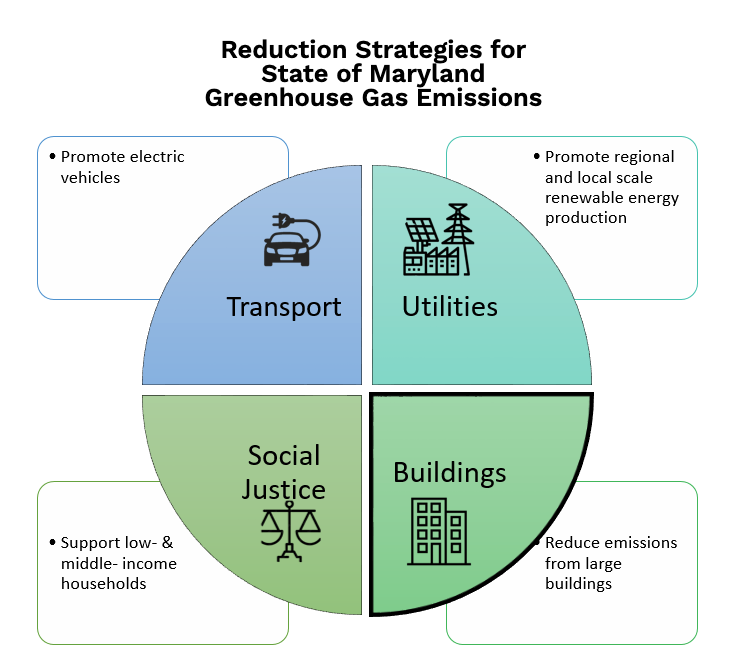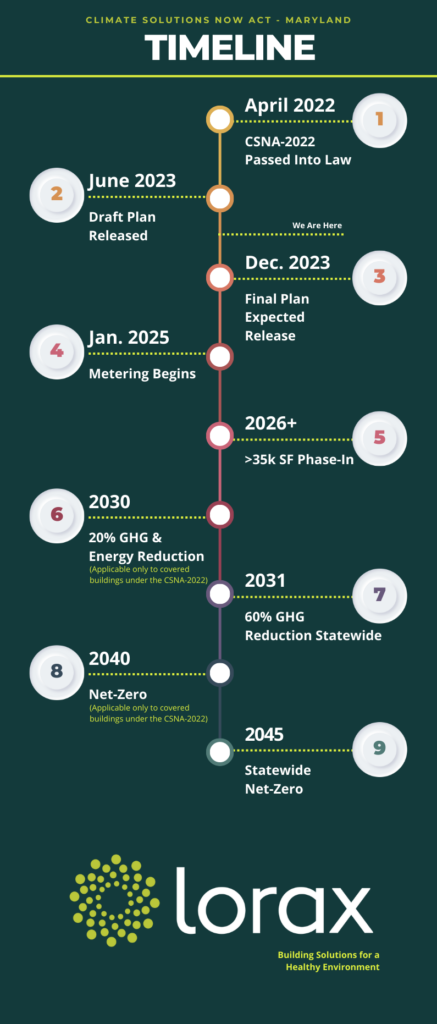A Comprehensive Guide for Maryland
August 16, 2023 | By: Matthew Torr
Summary:
- The Climate Solutions Now Act passed in April 2022 in Maryland, targeting greenhouse gas reduction across sectors like Buildings, Transportation, Utilities, & Social Justice.
- Focus is on electrifying infrastructure, reducing building emissions, promoting renewables, and encouraging electric vehicles.
- Maryland aims for net-zero carbon by 2045
- Known requirements include 2025 reporting for >35,000 SF buildings, with exemptions, mandatory energy utility metering, adoption of latest Energy Code within 18 months.
- Unknowns include energy baseline, carbon penalties, all-electric standard, awaiting clarity in December 2023 Final Plan release.
As you have likely heard across multiple media platforms, the Climate Solutions Now Act passed into law back in early 2022. Over the last year and change, there has been much speculation as to what the Act will fully entail and how it will be enforced.
Fear not fellow Americans (more specifically, Marylanders)! Lorax is here to help teams in navigating the Climate Solutions Now Act as we approach the final publication that is slated for December 2023. Our team of expert energy modelers and legislative advisors provide a digestible overview of what building owners and design teams can expect upon the final plan release. Below we touch on the timeline of implementation, the knowns, and the unknowns in order to help better prepare project teams for the future climate of building construction, with a focus on the impacts on Maryland development.
Navigating the Climate Solutions Now Act
The Climate Solutions Now Act was passed into law in April of 2022 and requires states to reduce their greenhouse gas (GHG) emissions by implementing several different GHG reducing strategies through goal setting. Simply put, the law focuses on four sectors, Buildings, Transportation, Utilities, & Social Justice, to help the state of Maryland to reduce its overall statewide greenhouse gas emissions.
Primarily, Maryland will focus on electrifying our infrastructure by reducing emissions from new and existing buildings, promoting renewable energy, and encouraging the use of electric vehicles.

Net-Zero by 2045
Based on the current timeline, as of August 2023, Maryland has a few major milestones on the horizon in the coming years. But if you are anything like me (wondering where the first half of 2023 has gone), you are wise enough to recognize that these target milestones will be here before you can say Environmental, Social, & Governance.
Among this timeline are substantial goals that have been set by the state in order to hold Marylanders accountable and push the state to its overall goal of net-zero carbon by 2045. These dates are important to keep in mind as, at some point or another, they will affect everyone. However, at this point, building owners and developers are the ones who should be most vigilant in the coming years as failure to comply could result in a hefty fine!
(As I always told my students, it is always better to be proactive than reactive. This roughly translates to, take the steps now to plan ahead of the curve before it comes back to bite you later.)
The Known Requirements
Now, as eager as you may be for the Final Plan of the Climate Solutions Now Act to be released at the end of this year, there is more value in looking ahead at what we know today and starting to plan for the expected – and required – changes. Here is what we know based on the Draft Plan of the CSNA-2022:
- Reporting requirements start in 2025 for all building types covered under the legislation
- Reporting will be required through ENERGY STAR Portfolio Manager
- This includes all buildings 35,000 SF and larger
- Some building types such as, historic, manufacturing, commercial kitchens, schools, and agricultural buildings are exempt, but the definitions of which buildings are exempt has not been made clear to date
- Smaller buildings (under 35,000 SF) will be phased-in at a later date
- All energy utilities must be metered and reported
- Maryland must adopt the most recent International Energy Code within 18 months of publication
The Unknown Factors
The old saying, “You don’t know what you don’t know” couldn’t be truer in the circumstance of what exactly is ahead with the Final Draft of the Climate Solutions Now Act; so we are only able to speculate based on what we do know.
From what we have gathered from the Draft Plan, we are certain that we will at least see the following:
- There will be an Energy Baseline
- Will this be a prescribed ASHRAE baseline, Energy Star rating, or using the 2025 measured data?
- Penalties will be very likely tied to the social cost of carbon
- This is currently listed at $51 per ton by the EPA
- There is a proposal to raise cost to $200 per ton in 2023
- What will the cost be in 2030?
- An All-Electric Standard
- The BEPS proposals have both an energy (EUI) and carbon (GHG) metric, which incentivizes electrification
- Will there be a mandate? Likely not, but the future is still uncertain.
Although we have covered as much as we know from the Draft Plan to the Climate Solutions Now Act, we eagerly await to confirm the unknowns and gain further insight into the goals and milestones that await us with the release of the Final Plan in December. Until then, we can only continue to speculate what the future holds. One thing we know for sure, Maryland is on a path to creating a healthier, cleaner, and more sustainable future for its residents.
If you are curious to learn about ways to prepare for the CSNA, take a look at our other blog post on strategies to mitigate risks of the Climate Solutions Now Act 2022 or reach out to our Director of Energy Services, Casey Ross, to discuss how your project could be affected.

